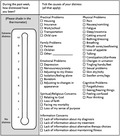- Record: found
- Abstract: found
- Article: found
Screening for Psychological Distress in Vietnamese Cancer Patients: An Evaluation of the Distress Thermometer

Read this article at
Abstract
Background
Psychological distress is prevalent in patients with cancer, negatively affecting their treatment and quality of life. Clinical guidelines recommended screening all cancer patients routinely for psychological problems using simple measures such as the Distress Thermometer (DT) and Problem List (PL). This study is the first research in Vietnam to identify the optimal DT cutoff point to screen distress and the relationship with PL items among cancer patients.
Methods
300 cancer patients were recruited from 10 departments at Vietnam National Cancer Hospital (K hospital) and completed the DT and PL. Participants also completed the Patient Health Questionnaire‐9 (PHQ‐9) and the Generalized Anxiety Disorder‐7 (GAD‐7) with standard cutoff scores for identifying significant depression and anxiety.
Results
Receiver operating characteristic (ROC) curve analyses showed that a DT cutoff score of 4 had an area under the ROC curve of 0.81 and 0.82 using the PHQ‐9 and GAD‐7 cutoff scores of 10 as the criterion, respectively. This indicated good overall accuracy. This cutoff also showed a sensitivity of 0.87 and 0.92 for PHQ‐9 and GAD‐7 total score defined cases, respectively. Both specificity values were 0.58. In terms of the PL, 164 distressed patients (54.7%) reported significantly more emotional problems, family issues, and practical and physical problem, implying various causes contribute to psychological distress among cancer patients.
Conclusions
The study showed that the DT with a cutoff of 4 accompanied with PL is a simple and effective instrument compared to previous, longer measures commonly used to detect psychosocial distress in Vietnamese cancer patients. This cutoff point also identified patients with problems contributing towards distress.
Abstract
The psychosocial aspects of cancer are usually underestimated and unrecognized. It is of necessity to use a short and simple screening measure for significant psychological problems of this vulnerable population. Our study is the first study in Vietnam to prove that the Distress Thermometer with the cutoff score of 4 accompanied with the Problem List is valid to Vietnamese people with cancer.
Related collections
Most cited references27
- Record: found
- Abstract: found
- Article: not found
A brief measure for assessing generalized anxiety disorder: the GAD-7.
- Record: found
- Abstract: found
- Article: not found
